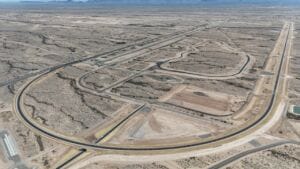KORE Power has chosen Buckeye, Ariz. as the location for its first lithium-ion battery production facility. The plant is slated to be a 1-million-square-foot “KOREPlex” that employs 3,000 full-time workers.
KORE has promised that the facility will operate with net-zero carbon emissions and that it could produce enough power for up to 3.2 million homes. Further, it “will support up to 12 gigawatt hours (GWh) of battery cell production.”
READ ALSO: Here’s why the West Valley is exploding with economic growth
According to a press release from the company, KORE Power is “the leading U.S.-based developer of battery cell technology for the energy storage and electric transportation industries.”
KORE’s selection of Arizona for its first factory comes amid a boom in the state’s economic prospects and the rapid expansion of its technology sector. Maricopa County, which is home to the city of Buckeye, is now the fastest growing county in the nation by population, and the fifth-largest county in America.
Strengthening America’s domestic battery supply chain
Lithium-ion batteries undergird everything from iPhones to energy storage, and their importance spans nearly every industry. This is increasingly true as technology develops further and people across the world become more digitally integrated.
China currently dominates lithium-ion battery supply chains, while the United States lags behind, ranked 6th place globally. China has 93 “gigafactories” which manufacture battery cells, while the U.S. only has 4. Future projections are bleak: China is slated to have 140 by 2030, and the U.S. is estimated to have 10 based on the country’s current trajectory. Even Europe will have more of these factories than America, with a projected 17 gigafactories by 2030.
The challenge extends beyond manufacturing capacity, however, and reaches into mineral extraction and processing. In fact, there is only one lithium mine in all of North America, located at Silver Peak, Nev. According to the U.S. Geographical Survey, “Six mineral operations in Australia, two brine operations each in Argentina and Chile, and one brine and one mineral operation in China accounted for the majority of world lithium production.”
These combined statistics illustrate the niche that KORE sees itself filling. Marketing itself as the first American domestic lithium battery production company, KORE Power could lead the next generation of American high-tech manufacturing.
The Biden Administration’s focus on shifting supply chains closer to home lines up neatly with the company’s goals.
Warm welcome
Arizona leaders are welcoming KORE and its lithium-ion battery factory to the growing silicon desert.
Gov. Doug Ducey said, “Not only will this facility create thousands of new jobs, it will position Arizona as an anchor in the global battery manufacturing supply chain. We’re grateful to CEO Lindsay Gorrill and the entire KORE Power team for choosing our state. We look forward to partnering in your success for many years to come to further sustainability here in Arizona around the world.”
Arizona Sen. Kyrsten Sinema said, “I join all Arizonans in welcoming to our state KORE Power and its new manufacturing site that will create thousands of new jobs. Arizona is positioned to lead the nation on increasing America’s competitiveness in battery technology, and I will continue supporting this vital industry.”
Emphasizing the role that battery technology will play in efforts to combat climate change, Sen. Mark Kelly said, “As one of the nation’s top producers of clean energy technologies, KORE Power plays an important role in maintaining American energy independence. This investment in our electric vehicle infrastructure and climate resiliency will continue to advance Arizona’s leadership in the tech sector as well as help our nation achieve its renewable energy goals.”The Arizona Commerce Authority projects that the new project will create 10,000 direct and indirect jobs, not to mention the 3,400 workers who will be employed to construct the facility over an approximately 18-month period.




